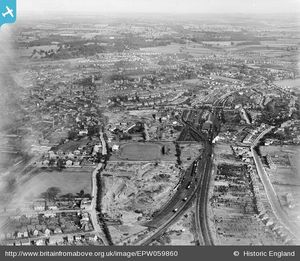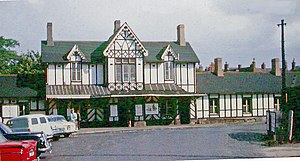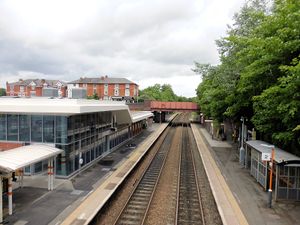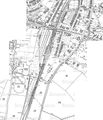Difference between revisions of "Kidderminster mainline station"
(→Locomotive shed: additional info) |
(→Goods yard: additional info) |
||
| Line 36: | Line 36: | ||
The goods yard consisted of the 'Top Yard' between Comberton Road and the [[Kidderminster Footbridge]] (the area now mainly occupied by the SVR station) and the 'Bottom Yard' beyond the Footbridge, now mainly occupied by the SVR’s [[Diesel Depot]] and [[Kidderminster Carriage Shed]]<ref name=Turley>[[Bibliography#Books|Turley (2005)]] p. 13.</ref>. | The goods yard consisted of the 'Top Yard' between Comberton Road and the [[Kidderminster Footbridge]] (the area now mainly occupied by the SVR station) and the 'Bottom Yard' beyond the Footbridge, now mainly occupied by the SVR’s [[Diesel Depot]] and [[Kidderminster Carriage Shed]]<ref name=Turley>[[Bibliography#Books|Turley (2005)]] p. 13.</ref>. | ||
| − | The yard | + | The yard handled general goods traffic from the Severn Valley and Tenbury branches and elsewhere. By the mid-20th century the main local industries served were Carpets (jute from Dundee arriving, finished products leaving) and Sugar (beet, limestone and coal arriving, refined sugar and molasses leaving). The yard was extremely busy, with shunting taking place continuously from 6.00am on Monday to 2.00pm on Sunday.<ref name=Turley/> The 1946 Service Timetable included the following details: |
| − | + | <div style="background:#fcfcfc; border-style:solid; border-width:2px; border-color:#895920; margin:20px 10px; padding:5px;"> | |
| + | ENGINE No 1. | ||
| + | :Start 6.0 am Monday morning | ||
| + | :Shunt Yard, etc., trip to [[Foley Park]] 9.5 am, and trip Bewdley to Kidderminster, 12.50 pm. | ||
| + | :Trip to [[H. Whitehouse's Sand Siding|Whitehouse's siding]] 2.0 pm, and trip to Foley Park 5.0 pm. :Engine changed daily at 1.0 pm. | ||
| + | :To shed 2.0 pm Sunday. | ||
| + | ENGINE No 2. | ||
| + | :Start 4.0 pm. | ||
| + | :Shunts New Coal Yard and Mileage Sidings. To shed 12.0 midnight. Engine out continuously during Beet Season. | ||
| + | </div> | ||
| + | |||
| + | During the 1940s the regular yard shunter was normally a [[Locomotives used on the Severn Valley Branch in commercial service|57xx 0-6-0PT]] drawn from those available at Kidderminster. They included No. 8727 in particular, but also Nos. 8718, 4625, 4641 and 3609. 3609 was damaged in a shunting accident in the yard in October 1944 and replaced by No. 7700. The main yard shunter was paired with a [[GWR 41736 Shunters Truck|Shunters Truck]], No. 41803 (built in 1901) and later No. 41098 (built in 1938). The Coal Yard evening shunt was carried out by the Shrewsbury 0-6-0 tender engine which had worked that day's Up goods, or from the mid-1940s by any available Kidderminster engine.<ref>[[Bibliography#Books|Turley (2005)]] p. 81.</ref> | ||
| + | |||
| + | The yard's main goods shed now serves as the SVR's [[Carriage Repair Works]]. During the GWR era, steam locomotives were prohibited from entering the goods shed. The GWR kept two shunting horses in a stable on the opposite side of the main line behind the carriage siding, one of which would be led across the tracks each day. Two men were required to manage shunting in the shed, one to tend the horse and the other the wagons. Messrs. Harvey & Co also employed a shunting horse to move wagons around their [[J.P.Harvey's Corn Mill|private siding]].<ref>[[Bibliography#Books|Turley (2005)]] p. 83.</ref> | ||
| + | |||
| + | [[Kidderminster Railway Museum]] occupies a smaller warehouse built by the GWR in 1878 for grain and wool storage. The LMS, which had running rights in the area, had a depot known as a 'goods receiving office’ which was a short way from the station near the bottom of Comberton Hill<ref>Worcester to Birmingham, Mitchell and Smith, 2007, fig. 34.</ref>. | ||
| + | |||
| + | [[Thomas Bantock|Thos. Bantock & Co.]] acted as the GWR's agent's representative at Kidderminster and also at [[Stourport]] and [[Bewdley]]. | ||
===Locomotive shed=== | ===Locomotive shed=== | ||
Revision as of 16:06, 17 November 2020
The SVRSevern Valley Railway's Kidderminster Town Station which opened in 1970 was built on the former goods yard of Kidderminster mainline station. The mainline station opened as part of the Oxford Worcester and Wolverhampton Railway in 1852 and become a direct destination for services from the Severn Valley Branch and Wyre Forest Line in 1878. Today it is managed by West Midlands Railway and forms part of the Birmingham to Worcester line. It has two platforms, with the main station building located on Platform 1, the DownIn reference to the direction of travel means away from the major terminus (i.e. towards Bridgnorth on the present day SVR) (northbound) platform. The SVRSevern Valley Railway and mainline stations are less than 100 yards apart and share the same station approach road.
Kidderminster mainline station history

The Kidderminster mainline station was built as part of the Oxford Worcester and Wolverhampton line between Stourbridge and Evesham which opened with a special train on 1 May 1852, with normal services beginning 2 days later.[1] At opening, both platforms ended at the Comberton Road bridge. The station building was a simple wooden structure which soon proved inadequate and was replaced in 1859 by a second building, also of wooden construction. This was described in a contemporary newspaper article as "…but one story in height, and comprised a booking office, two waiting rooms, a telegraph office, and closets, the entrance for passengers being by a door between the booking office and the waiting room. At the southern end was the telegraph office, a small compartment partitioned off from the booking office, and at the northern end, but detached at a distance of about three yards, was another wooden building, of recent erection, occupied by Mr. Done, of Kidderminster, as first and second-class refreshment rooms."[2]
On 1 July 1860 the OWWOxford Worcester and Wolverhampton Railway became part of the West Midland Railway (WMR) (a short-lived company not to be confused with the present operators of the station). The opening of the Severn Valley Railway on 1 February 1862 had no direct impact on Kidderminster, which could only be reached via a change at Hartlebury.
On the night of 14-15 February 1863 the second station building was destroyed by fire. Within days the OWWOxford Worcester and Wolverhampton Railway began construction of a third station building, which was substantially complete by May. A contemporary newspaper report noted that this "…will consist of a central building in the Elizabethan style, two stories high. This will comprise the booking offices and station-master's residence. To the left of this will be the waiting-rooms, and to the right the refreshment-rooms, offices, porter's-rooms, etc. The foundation is of stone, upon which a wooden framework is built filled up with bricks. The wooden portion is to be stained and varnished, and the brickwork covered with cement."
On 1 August 1863, the WMR was amalgamated with the Great Western Railway (GWRGreat Western Railway) which assumed responsibility for its operations.
The GWRGreat Western Railway opened the loop line to Bewdley on 1 June 1878, giving direct access to Kidderminster from Bewdley and stations further up the Severn Valley Branch and Wyre Forest Line. In anticipation of the additional traffic this would bring, new buildings were added to the UpIn reference to the direction of travel means towards the major terminus (i.e. towards Kidderminster on the present day SVR) (southbound) platform during 1877-78, including a general waiting room, a ladies waiting room, luggage and porters rooms. A footbridge was also installed to connect the two platforms.[2]
By 1900 there had been an upsurge in excursion traffic to places like Blackpool and the Welsh coast resorts. In that year, in order to cater for longer trains, the northbound platform was extended beyond the Comberton Road bridge to create the "Excursion Platform" as it became known, with an additional access ramp from Comberton Road.[2] The extension required the re-siting of the Kidderminster Station signal box which was demolished and rebuilt a few feet nearer the running line to improve visibility for the signalman.
In 1917 the Comberton Road bridge was widened and the southbound platform extended under bridge.[2]
In 1937 it was announced that "The sidings at Kidderminster are to be remodelled and new goods loop lines are to be added to facilitate the working of trains between there and Worcester."[3]
By the 1940s, nearly 300 railwaymen were employed at Kidderminster in various capacities including the passenger station, goods depot and goods yard, locomotive shed, traffic department, P-way and S&TSignals & Telegraph.[4].
September 1962 saw the end of passenger services north of Bewdley on the Severn Valley Branch, although they continued around the Kidderminster / Bewdley / Hartlebury triangle until January 1970.
In 1968 the 1860s station building was demolished due to dry rot, while the footbridge was also demolished. The simple BRBritish Rail or British Railways brick building which was built to replace it opened on 3 July 1974.[2]
In 1982 freight traffic from Foley Park ended, and the Directors of the SVRSevern Valley Railway were 'keeping a close watch' on the situation. Kidderminster Goods Depot was formally closed by BRBritish Rail or British Railways on 16 May 1983, and negotiations began in earnest with BRBritish Rail or British Railways on leasing an area of land in the freight yard to establish the SVRSevern Valley Railway's proposed new station. By February 1984 the exchange of contracts with BRBritish Rail or British Railways had taken place to purchase the line from Foley Park to Kidderminster and lease an area of the Goods Yard for construction of Kidderminster Town Station, which opened in July of that year.
A new footbridge in the mainline station was opened in 2009. In 2018 work began on a major upgrade which included reconfiguration of the existing road and forecourt area as well as demolition and replacement of the 1974 station building.[5] The new station building was opened on 7 June 2020[6].
Goods yard
The goods yard consisted of the 'Top Yard' between Comberton Road and the Kidderminster Footbridge (the area now mainly occupied by the SVRSevern Valley Railway station) and the 'Bottom Yard' beyond the Footbridge, now mainly occupied by the SVRSevern Valley Railway’s Diesel Depot and Kidderminster Carriage Shed[7].
The yard handled general goods traffic from the Severn Valley and Tenbury branches and elsewhere. By the mid-20th century the main local industries served were Carpets (jute from Dundee arriving, finished products leaving) and Sugar (beet, limestone and coal arriving, refined sugar and molasses leaving). The yard was extremely busy, with shunting taking place continuously from 6.00am on Monday to 2.00pm on Sunday.[7] The 1946 Service Timetable included the following details:
ENGINE No 1.
- Start 6.0 am Monday morning
- Shunt Yard, etc., trip to Foley Park 9.5 am, and trip Bewdley to Kidderminster, 12.50 pm.
- Trip to Whitehouse's siding 2.0 pm, and trip to Foley Park 5.0 pm. :Engine changed daily at 1.0 pm.
- To shed 2.0 pm Sunday.
ENGINE No 2.
- Start 4.0 pm.
- Shunts New Coal Yard and Mileage Sidings. To shed 12.0 midnight. Engine out continuously during Beet Season.
During the 1940s the regular yard shunter was normally a 57xx 0-6-0PT drawn from those available at Kidderminster. They included No. 8727 in particular, but also Nos. 8718, 4625, 4641 and 3609. 3609 was damaged in a shunting accident in the yard in October 1944 and replaced by No. 7700. The main yard shunter was paired with a Shunters Truck, No. 41803 (built in 1901) and later No. 41098 (built in 1938). The Coal Yard evening shunt was carried out by the Shrewsbury 0-6-0 tender engine which had worked that day's UpIn reference to the direction of travel means towards the major terminus (i.e. towards Kidderminster on the present day SVR) goods, or from the mid-1940s by any available Kidderminster engine.[8]
The yard's main goods shed now serves as the SVRSevern Valley Railway's Carriage Repair Works. During the GWRGreat Western Railway era, steam locomotives were prohibited from entering the goods shed. The GWRGreat Western Railway kept two shunting horses in a stable on the opposite side of the main line behind the carriage siding, one of which would be led across the tracks each day. Two men were required to manage shunting in the shed, one to tend the horse and the other the wagons. Messrs. Harvey & Co also employed a shunting horse to move wagons around their private siding.[9]
Kidderminster Railway Museum occupies a smaller warehouse built by the GWRGreat Western Railway in 1878 for grain and wool storage. The LMSLondon Midland & Scottish Railway, which had running rights in the area, had a depot known as a 'goods receiving office’ which was a short way from the station near the bottom of Comberton Hill[10].
Thos. Bantock & Co. acted as the GWRGreat Western Railway's agent's representative at Kidderminster and also at Stourport and Bewdley.
Locomotive shed
- Main article: Kidderminster Shed
Kidderminster had a small single-road locomotive shed which was situated close to the main line station, on the east side of the running lines opposite the main goods shed. The original shed, which was built by the OWWOxford Worcester and Wolverhampton Railway, dated from the opening of the station in 1852. It was of wooden construction and was closed at the north end. The 1885 map below suggests it was accessed from the south end via a turntable. It was rebuilt during 1899 as a through shed, accessed by a set of points with a head shunt as shown in the 1902 and 1924 maps.[11]
In February 1932 the small shed was closed and replaced by a new larger depot built on the south side of the line between Hoo Road Bridge and Worcester Road Bridge[12]. The 1938 map suggests the small shed and associated point work had been removed by that time.
Historic maps of Kidderminster Station
- 1885 map showing the station and goods yard and two sidings extending to the south.
- 1902 map showing the expanded goods yard with sidings extending in to gravel and sand pits.
- 1924 map showing the extended Excursion Platform to the north and several more sidings.
- 1938 map showing further expansion of the goods yard and sand pit.
Gallery
Kidderminster station, 1959 (Sellick Collection)
See also
- Kidderminster Town Station
- The Severn Valley Railway under GWR/BR ownership
- Mainline Operators Servicing Kidderminster
References
- ↑ Boynton (2002)
- ↑ 2.0 2.1 2.2 2.3 2.4 Kidderminster & District Archaeological & Historical Society Building Record of Kidderminster Railway Station.
- ↑ Meccano Magazine, January 1937 on Meccano magazine online web site
- ↑ Turley (2005) p. 17.
- ↑ SVRSevern Valley Railway NBINotice Board Issue. The SVR's on-line method of circulating information to working members. 5 September 2018
- ↑ Railway Gazette
- ↑ 7.0 7.1 Turley (2005) p. 13.
- ↑ Turley (2005) p. 81.
- ↑ Turley (2005) p. 83.
- ↑ Worcester to Birmingham, Mitchell and Smith, 2007, fig. 34.
- ↑ Railways in Worcestershire, Locomotive Sheds (retrieved 11 July 2020)
- ↑ Lyons (1972) p. 180.
Links
- National Rail: Kidderminster (KID) station details
- Wikipedia: Kidderminster railway station










